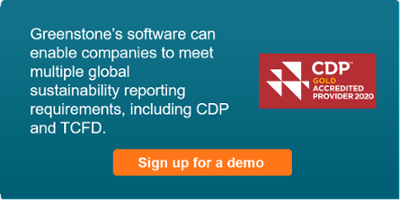Aligning global sustainability frameworks - FAQs and resources
 Following Greenstone and GRI’s recent webinar on ‘Aligning global sustainability frameworks – the role of software in mapping data’, below are the answers to some of the most frequently asked questions, plus some helpful resources.
Following Greenstone and GRI’s recent webinar on ‘Aligning global sustainability frameworks – the role of software in mapping data’, below are the answers to some of the most frequently asked questions, plus some helpful resources.
If we respond to CDP are we covering TCFD?
CDP has integrated the TCFD’s recommendations primarily into the climate change questionnaire, as there is already significant overlap between existing questions and the recommendations. CDP has also modified the structure of the climate change questionnaire to align more closely with TCFD recommendations structure and developed new sector-specific questions and guidance for the capital goods, construction, financial services and real estate sectors for the 2020 reporting cycle.
If you are submitting a response to the CDP Climate Change questionnaire, you should already be considering disclosure on TCFD-mapped questions, including on risks, opportunities and scenario analysis. Greenstone has incorporated this mapping into its Frameworks module to enable its clients to easily identify framework alignment and streamline data collection.
For more information, see CDP’s Technical Note on the TCFD.
Is the use of the GRI Standards required by regulation?
Although the GRI Standards are included in 168 policies in 67 different nations, for most organisations use of the GRI Standards is voluntary. Using a standard-based system creates a common language for organisations and creates a reliable and trusted structure for the stakeholders reading the reports. GRI is a neutral body that can help organisations make difficult decisions on what information to publish and be truly transparent on aspects that are material to their organisation.
How are the GRI Standards updated?
The GRI Standards are created and managed by the Global Sustainability Standards Board (GSSB), an independent board of directors, following a specific due process protocol. Each of GRI’s 37 standards are developed in the public interest through a transparent and inclusive process with all content developed by multi-stakeholder project working groups comprised of topic-specific experts and practitioners from constituencies around the world, including business, civil society, investors, mediating institutions, academics and regulators.
Each standard is regularly reviewed to ensure they are best in class. When an update to a standard is deemed necessary, a Project Working Group is convened through an independent nomination process. The group will extensively research the indicators that organisations should be reporting on and develop a draft updated standard, which will go for public comment for feedback. The feedback will be incorporated and an updated draft will be posed for final approval by the GSSB. The entire process takes around 18 months or so.
What’s the timeline for companies needing to start using the EU taxonomy?
The European Commission adopted the Taxonomy Regulation on 18 June 2020 and it enters into force on 12 July 2020. As the Taxonomy is still in its infancy, it is expected to evolve over time. The Technical Working Group on Sustainable Finance (TEG) recommendations are expected to be finalised this summer (2020).
From there, large companies should disclose during 2022 (covering the financial year 2021, with publication in the course of 2022) on climate change mitigation and adaptation only, and during 2023 (covering financial year 2022, with publication in the course of 2023) for all environmental objectives.
Financial Market Participants should disclose during 2021, with a deadline of 31 December 2021 for climate change mitigation and adaptation only and during 2022, with a deadline of 31 December 2022 for all environmental objectives.
Resources
Visit our Frameworks & Standards content library aiming to keep you informed with the latest industry updates and learn more about the available sustainability and ESG frameworks and standards to support your company's reporting.
Webinars
Aligning global sustainability frameworks – the role of software in mapping data
EU Taxonomy for sustainable finance – key impacts for companies and investors
BlackRock's sustainability announcement - how to respond
CDP reporting - preparing for 2020
TCFD disclosure – where to start and how to align it with other frameworks
Linkage documents
For GRI’s GRI Standards Linkage documents, visit the GRI Standards Resource Download Center.
Sustainability software
Greenstone’s sustainability reporting software has been certified by GRI’s Certified Software and Tools Program which guarantees that software and digital tools are using GRI content accurately, enabling robust and transparent reporting and making sustainability reports better, more accessible and easier to produce.
Greenstone’s award-winning Frameworks module enables users to meet the reporting requirements of global sustainability reporting frameworks including GRI Standards, CDP, UNGC, TCFD, SDGs, SASB and many leading financial exchange reporting schemes around the world including SGX, JSE SI, DJSI and FTSE4Good. Talk to us.










